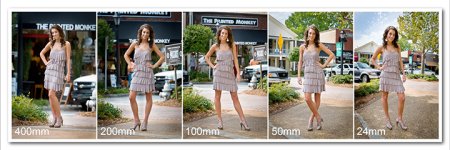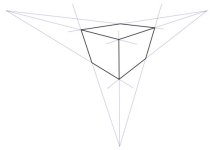If you want to believe the perspective of a shot has nothing to do with vanishing points, be my guest.
If vanishing points are too "hypothetical" for photographers (about all landscape and architecture photography is based upon it), I assume shooting identical shots at relative positions using hypothetical lenses and sensors in order to crop to identical proportions is more "real world" to them.
Not hypothetical at all, but more necessarily applicable to painting than photos. I do understand vanishing points, but I'm wondering if you do, why you would bring that cube up here in this discussion? Properties of your cube are real, but simply a distraction here, in the following sense: The photos you showed (of girl and building) are of course flat onto the building, not showing how the line of the building (or anything) recedes towards any horizontal vanishing points that you instead want to discuss somehow, This photo is a much simpler case, of simple near and far subjects, present in most photos (other than of flat documents maybe). The pictures you posted have no horizontal width or angles to show vanishing points (as you want to discuss with your cube.)
The simple vanishing point present in all photos is directly in front of the camera, on lens axis, receding into that distant frontal point.

I'm trying to get the subject back onto photography, the discussion subject should be the actual photos that show perspective.
The photo case is simpler than graphic painters face, just about apparent size differences, front to back, and side to side, up and down, apparent size dimensions due to distance. That is our photo perspective. It is pretty much just simple similar triangles, receding into the background. I am calling that perspective, because since we are not enrolled in elementary drawing classes, that is what we have. We are not creating a building on paper as we wish, we can only stand in front of it with our camera. The camera (with any lens) records what we see when we stand there. If we wish to see a different perspective, we can only stand someplace else. This is extremely obvious, not difficult, just forget your cube and think for a second.
I can't even make sense of the "where you stand" argument.
Take a baseball, put it on a table and shoot it with a 14mm at closest distance. Now you take a 600mm and reproduce that shot. You can stand wherever you desire to take the exact same shot with the exact same perspective distortion.
It does seem that you can't, but OK, I will call your statement. Lets see your baseball picture, standing in different places and showing "the same exact perspective" as you claim. I'd like to see how a lens can possibly create different perspectives (other than by standing someplace else - and I should rule out tilts and swings, not applicable here).

Any lens merely captures what it sees there.
Photo perspective is caused simply by the geometry of where we stand (meaning subject distance). Of course, we can only see what we see when we stand there.
All any lens can do in that same place is to take a picture of it, showing exactly what we see when we stand there. If we want any lens to see something different, we must stand at a different place. How hard is that?
Those differences in perspective simply can not be accomplished with another focal length while maintaining the same subject magnification.
Of course they can. Very easily. I just showed you in msg #6 of this thread.
The lens provides magnification of what we see, but really, the lens just frames the subject,
Where the camera stands determines perspective. What we see when we stand there is perspective.
If we want the same frame, yes, the lens is important too, frames are what lenses do.
If we want the same perspective, the place that the camera stands is
the only thing that matters. (where we stand means subject distance, but of course we can make horizontal changes too)
By your "subject magnification", I ignore any the surrounding frame, and only look at the subject magnification.
I just showed you how in the photos in #6 of this thread. I just told you how to do it in my #25 here. Do you not read? I am expecting better of you Jsee. Your problem is that you seem only able to "measure" perspective by the outer frame (I call that angle of field of view, which is not a factor of perspective). I judge perspective by how the subject actually looks, relative say to the background. The spatial relationship of objects in the scene is perspective. The frame is only a border.
The various photos showing perspective differences supposedly attributed to the different lenses are falsely misleading, since they are only possible by standing at different distances to fill the existing frame. The distance is what affects the perspective. The lens merely provides the frame. A useful frame, but the lens does not affect perspective.
Some of it is OK, but I am not a fan, so I cringe.There are other things, you ought to see their gamma page, they actually imagine gamma was done for the human eye.
How soon we forget.
Why is that difficult for you?





